In today’s digital age, securing personal and organizational data is more critical than ever. Traditional authentication methods like passwords and PINs are increasingly vulnerable to cyberattacks, with over 80% of data breaches involving compromised credentials.
Biometrics offers a revolutionary solution by using unique physical or behavioral traits—such as fingerprints, facial patterns, or voice—to verify identities. Unlike passwords, which can be forgotten, stolen, or shared, biometric traits are inherently tied to an individual, making them a robust tool for enhancing security.
Biometrics has evolved significantly since its origins in the 19th century, when Sir Francis Galton developed the first fingerprint classification system in 1892.
Today, powered by advancements in artificial intelligence (AI) and sensor technology, biometrics is integral to smartphones, border control, healthcare, and more. For individuals concerned about security and privacy, understanding biometrics is essential. While it offers unmatched convenience and protection, it also raises concerns about data breaches, surveillance, and ethical use.
This comprehensive guide dives deep into biometrics, exploring its types, mechanisms, applications, benefits, and challenges. We’ll address privacy and security concerns head-on, offering actionable insights for safeguarding your data. Additionally, we’ll examine emerging trends shaping the future of biometrics, ensuring you’re equipped to navigate this technology responsibly.
What Are Biometrics?
Biometrics refers to the measurement and analysis of unique biological or behavioral characteristics to identify or authenticate individuals. Derived from the Greek words “bios” (life) and “metron” (measure), biometrics literally means “life measurement.”
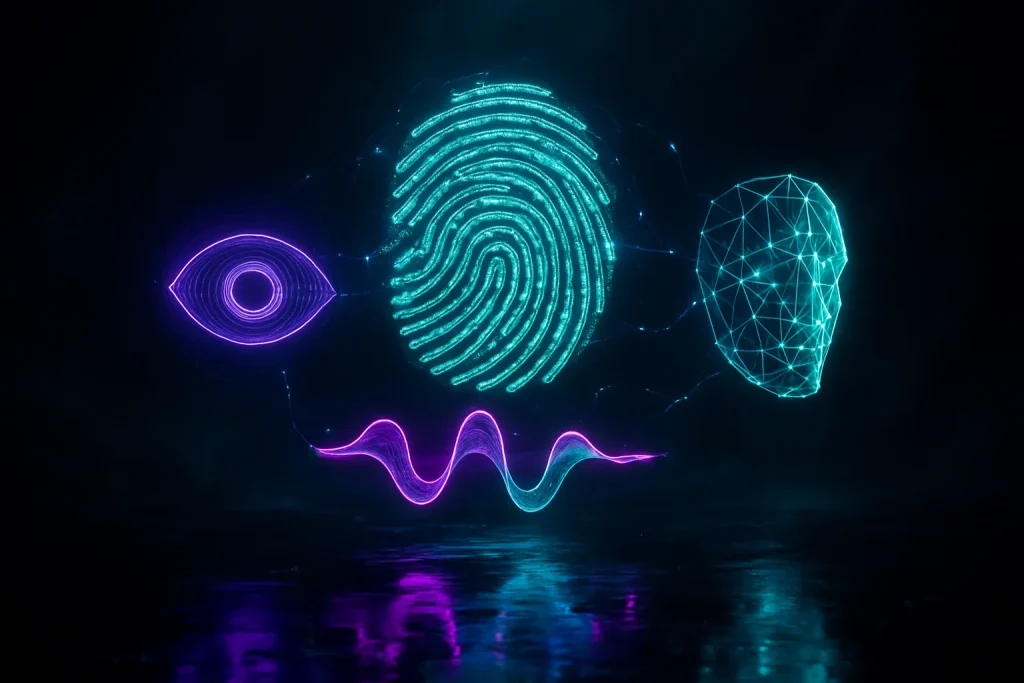
It encompasses a range of technologies that capture and analyze traits such as fingerprints, facial features, iris patterns, voice, or even behavioral patterns like typing rhythms. These traits are unique to each person, making biometrics a powerful tool for verifying identity in a way that passwords or ID cards cannot match.
Core Principles of Biometrics
Biometric systems are built on three core principles that ensure their effectiveness:
- Uniqueness: Each biometric trait must be sufficiently distinct to differentiate one individual from another. For example, no two people share identical fingerprints, even identical twins (Thales: Biometrics).
- Permanence: The trait should remain stable over time, with minimal changes due to aging or environmental factors. Fingerprints and iris patterns, for instance, remain consistent throughout most of a person’s life.
- Collectability: The trait must be measurable with practical, non-invasive technology. Facial recognition, for example, uses widely available cameras, making it easy to deploy (Kaspersky: Biometrics).
These principles enable biometric systems to provide reliable identification and authentication, distinguishing them from traditional methods that rely on something you know (passwords) or have (ID cards).
Biometrics vs. Traditional Authentication
Traditional authentication methods, such as passwords or PINs, suffer from significant vulnerabilities. Passwords can be forgotten, shared, or stolen, with studies showing that 59% of people reuse passwords across multiple accounts.
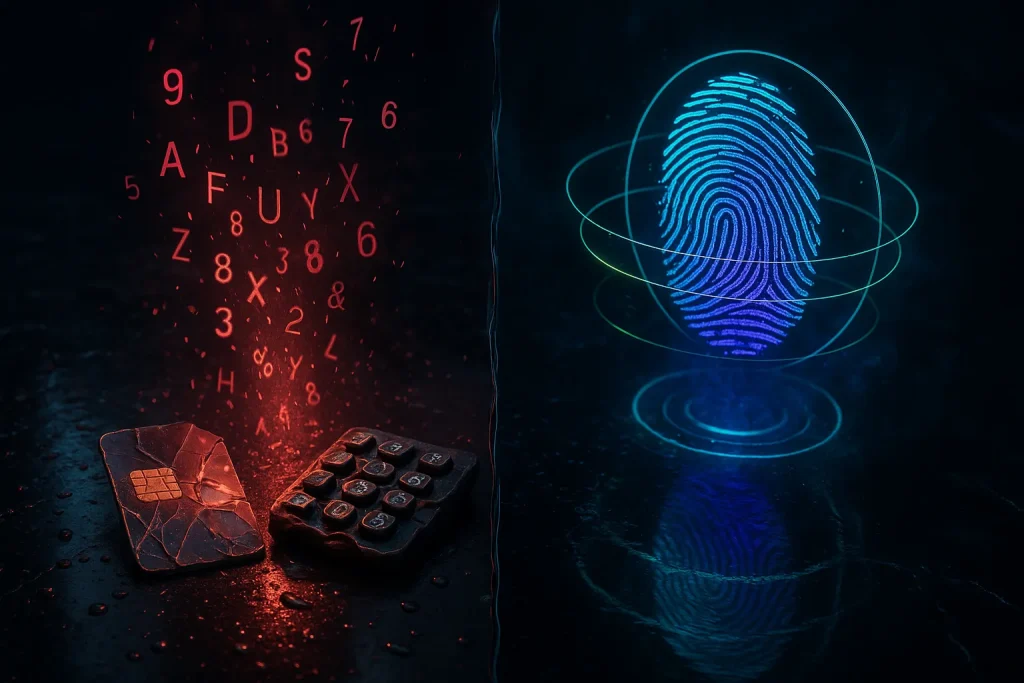
Physical tokens like ID cards can be lost or forged. Biometrics, by contrast, leverages traits that are:
- Inherent: Tied to the individual, eliminating the need to remember or carry anything.
- Non-transferable: Cannot be shared or delegated, reducing the risk of unauthorized access.
- Difficult to Replicate: While not impossible, forging biometric traits requires sophisticated techniques, unlike guessing a weak password.
However, biometrics is not infallible. If compromised, biometric data cannot be changed like a password, raising unique security and privacy challenges.
Types of Biometric Systems
Biometric systems are broadly classified into two categories based on their function:
- Identification: Determining “who” an individual is by comparing their biometric trait against a database of many templates. This is common in law enforcement, such as identifying a suspect via fingerprint matching in the FBI’s Next Generation Identification (NGI) system (DHS: Biometrics).
- Authentication (Verification): Confirming “if” an individual is who they claim to be by comparing their trait to a single stored template. This is used in smartphone unlocking, such as Apple’s Face ID.
Both systems rely on advanced sensors, algorithms, and secure storage to ensure accuracy and protect user data.
Historical Context and Evolution
Biometrics has a rich history rooted in human observation. Ancient civilizations used physical traits like facial features for identification, but modern biometrics began with Galton’s fingerprint system in the late 19th century.
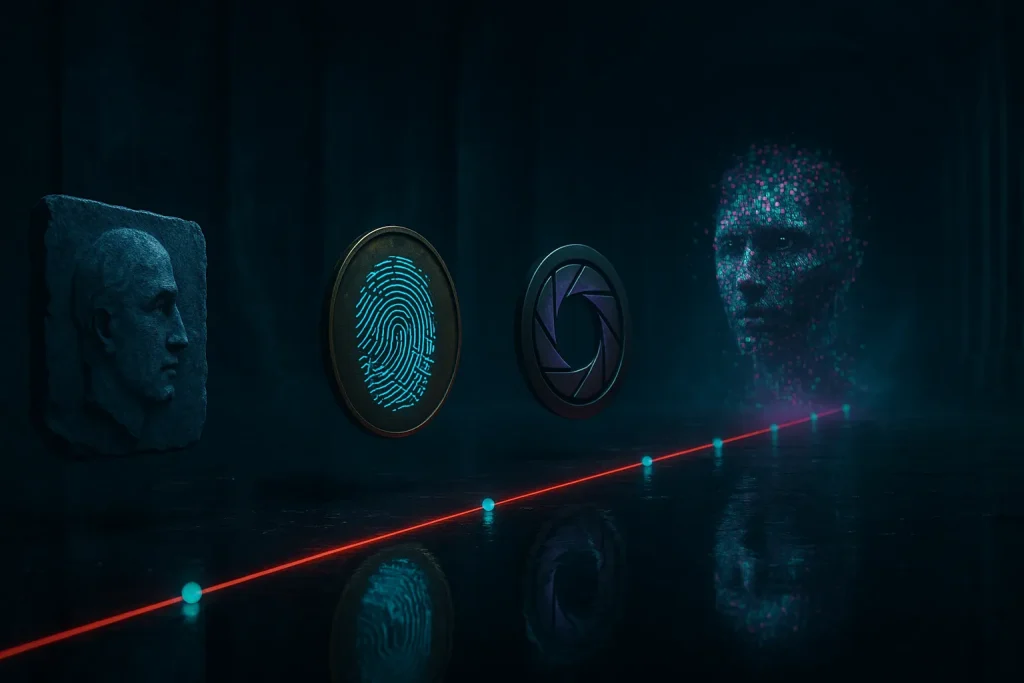
The 20th century saw advancements in fingerprinting for law enforcement, followed by the development of iris recognition in the 1980s by Dr. John Daugman. The digital revolution and AI have since expanded biometrics’ scope, enabling real-time facial recognition and behavioral analysis.
Today, biometrics is a $55 billion industry, projected to reach $82 billion by 2027, driven by demand for secure authentication in consumer electronics, finance, and government. Its integration into everyday devices, like smartphones and smart doorbells, underscores its growing accessibility and importance.
Why Biometrics Matters for Security and Privacy
For security-conscious individuals, biometrics offers a compelling alternative to traditional methods, reducing fraud and enhancing user experience. For example, biometric ATMs have cut card skimming incidents by up to 30% in some regions.

However, the permanence of biometric data raises privacy concerns. Unlike passwords, compromised biometric data cannot be reset, and breaches, like the 2015 U.S. Office of Personnel Management hack exposing 5.6 million fingerprints, highlight the stakes.
Understanding biometrics empowers users to weigh its benefits against risks, ensuring informed decisions about its use in personal and professional contexts.
Types of Biometrics
Biometric identifiers fall into two primary categories: physiological and behavioral. Each leverages distinct human characteristics, offering unique advantages and use cases.
Below, we explore these types in detail, highlighting their applications, strengths, and limitations.
Physiological Biometrics
Physiological biometrics use physical traits that are generally stable throughout a person’s life. These traits are highly reliable for identification due to their uniqueness and permanence.
Fingerprints: Fingerprint recognition is still the most common consumer biometric. Every finger shows one of three ridge patterns (loops, whorls, or arches), but the truly identifying features are the minutiae — ridge endings, forks, dots, and enclosures.
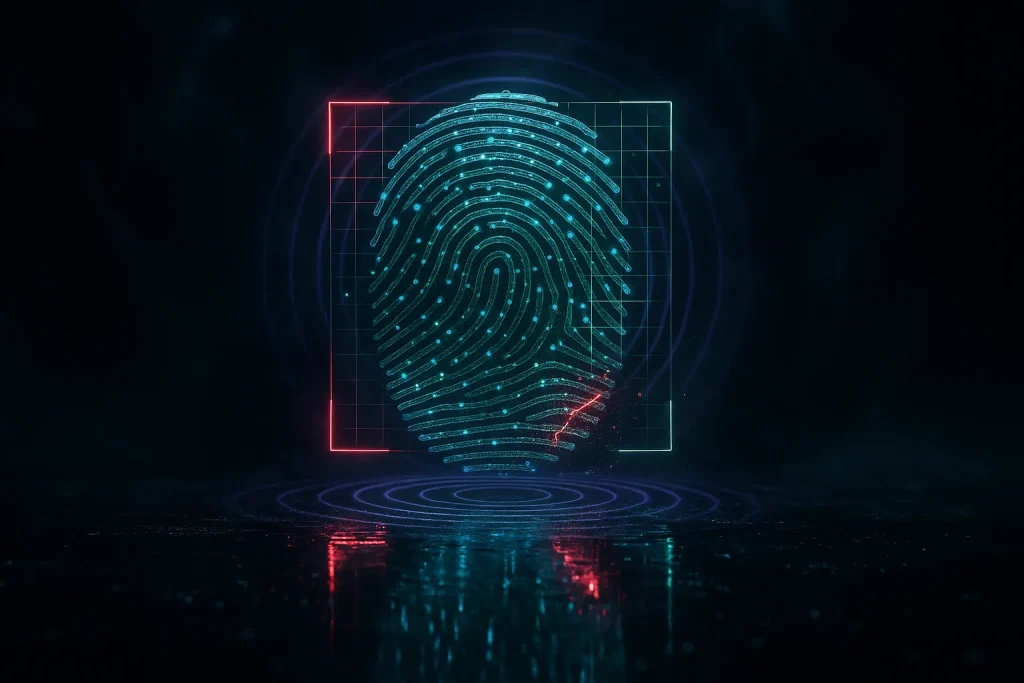
Modern readers match these minutiae so they can authenticate from only a small, angled scan.
Consumer scanners fall into three groups:
- Optical: A tiny camera captures a two-dimensional photo. It is inexpensive and easy to place under a display, yet it can be fooled by a high-resolution image and often struggles in bright sunlight.
- Capacitive: A grid measures electrical differences between ridges and valleys. It resists photo attacks and most fake fingers and will not read dead tissue, but moisture can cause failures.
- Ultrasonic: The sensor sends ultrasound pulses and builds a three-dimensional depth map. It works through dirt, light sweat, and many screen protectors, though it costs more and lacks the “dead-finger” safeguard.
Fingerprint unlock is still vulnerable to coercion because someone can physically press your finger on the reader. Gloves and some aftermarket screen protectors also block the scan, so keep the sensor uncovered.
Facial Recognition: This method analyzes facial features, such as the distance between eyes, nose shape, and jawline, using 2D or 3D imaging. Facial recognition powers Apple’s Face ID and is used in surveillance systems worldwide.

Its non-intrusive nature makes it ideal for applications like airport security, where the U.S. Customs and Border Protection’s Traveller Verification System (TVS) processes millions of travelers annually.
However, accuracy can vary based on lighting, angles, or facial changes like aging or makeup. Privacy concerns also arise, as facial data can be collected without consent in public spaces.
Facial Recognition: Current phones use three approaches.
- Plain 2-D camera: relies on the selfie camera alone and can be fooled by a printed photo; accuracy drops in low light.
- 2-D infrared: adds an infrared camera and emitter for better low-light performance and stronger photo resistance, yet still treats the face as flat.
- 3-D structured-light mapping: projects thousands of invisible infrared dots and measures their depth to build a three-dimensional mask. Apple says the chance of a random unlock with Face ID is under one in a million versus about one in fifty thousand for Touch ID. Three-dimensional systems defeat photos and most masks but may still admit an identical twin.
Activate an “attention” setting that requires your eyes to look at the screen before unlocking, and note that mask-compatible modes reduce security.
Iris and Retina Scans: Iris scans capture the intricate patterns of the eye’s iris using near-infrared cameras, offering unmatched accuracy with false match rates as low as 1 in 10 million.
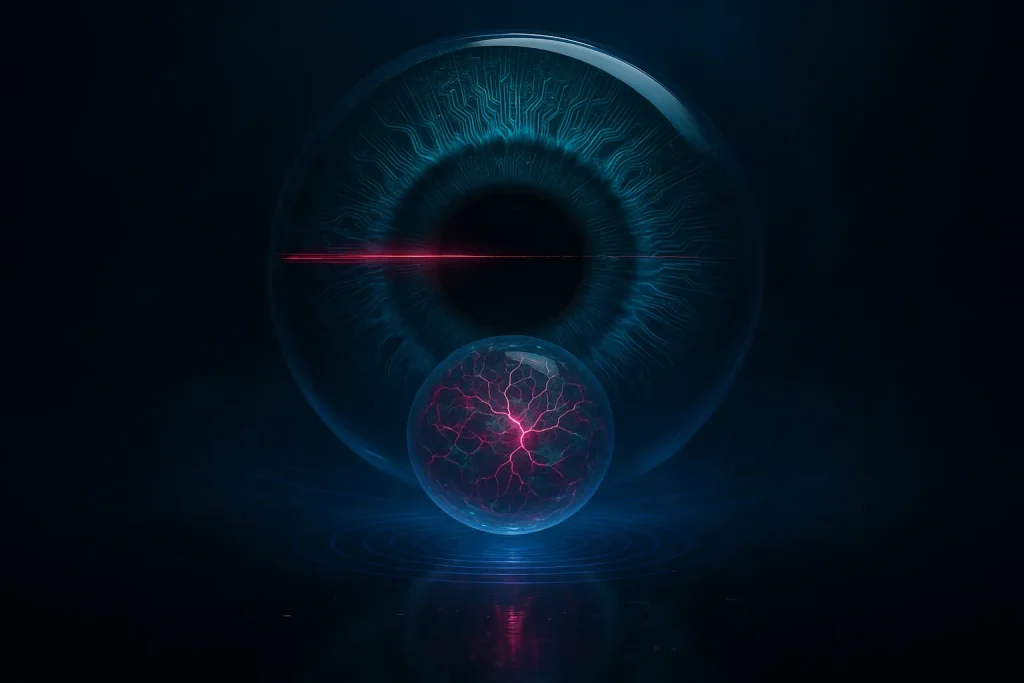
Retina scans, which map blood vessel patterns at the back of the eye, are even more secure but require specialized equipment. Both are used in high-security settings like military bases and airports. Their limitations include high costs and user discomfort due to close-range scanning.
DNA: DNA biometrics analyzes genetic material, providing a definitive identifier since no two individuals (except identical twins) share the same DNA.

It’s primarily used in forensics, such as identifying remains or solving crimes, due to the time-intensive process and need for laboratory analysis. While highly accurate, DNA biometrics is impractical for real-time authentication.
Hand Geometry: This measures hand dimensions, such as finger length, width, and curvature. It’s used in access control systems, notably at Disney theme parks for ticket verification.
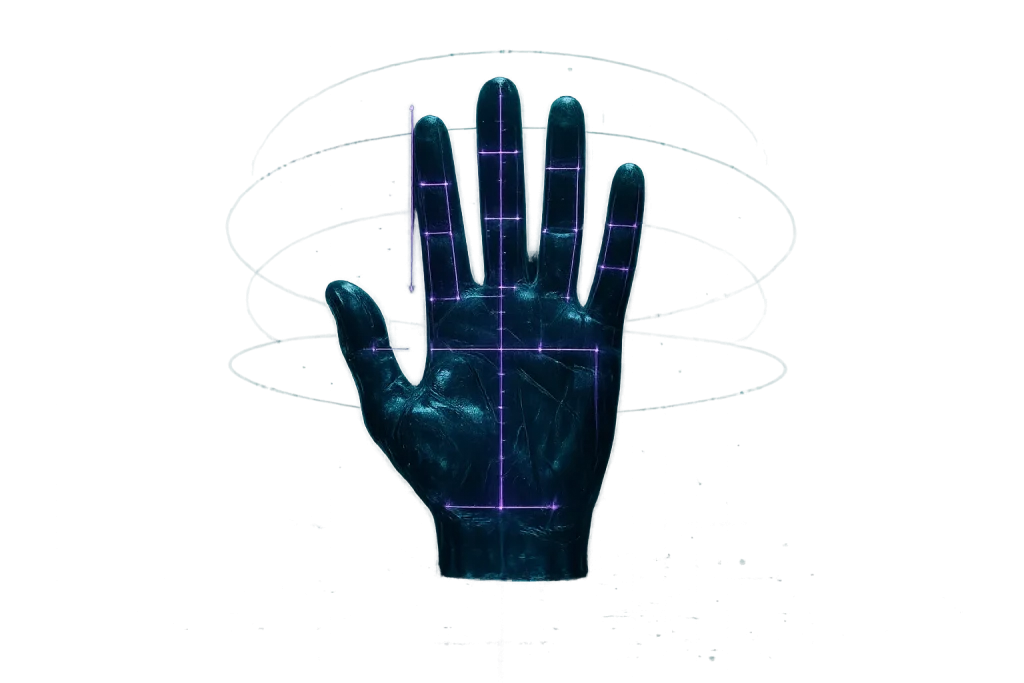
Hand geometry is less invasive than iris scans and suitable for large-scale deployments, but its accuracy is lower than fingerprints or iris scans.
Vein Patterns: Vein recognition maps the unique vascular patterns in a person’s hand or finger using near-infrared light. It’s highly secure, as veins are internal and difficult to replicate, and is used in banking and healthcare.

For example, Japan’s ATMs often employ palm vein authentication. The technology requires specialized hardware, which can increase costs.
Behavioral Biometrics
Behavioral biometrics analyze patterns in human actions, which may evolve over time but remain distinctive enough for authentication. These methods are often used for continuous verification, enhancing security in dynamic environments.
Vendors such as TypingDNA now package keystroke profiles as a second authentication factor for web logins or as continuous verification on corporate laptops. If you want to avoid being profiled this way online, draft text in a local editor and paste it into the browser instead of typing directly.
Voice Recognition: Voice biometrics analyzes vocal characteristics like pitch, tone, and frequency. It’s used in call centers, smart assistants like Amazon’s Alexa, and banking for remote authentication.

Voice recognition is non-intrusive and user-friendly but can be affected by background noise or vocal changes due to illness. Advanced systems use AI to improve accuracy, achieving error rates below 1%.
Gait Analysis: Your walking style is distinctive enough to identify you from a distance. Camera systems do this with two methods: model-based tracking of a stick-figure skeleton and model-free comparison of full silhouettes.
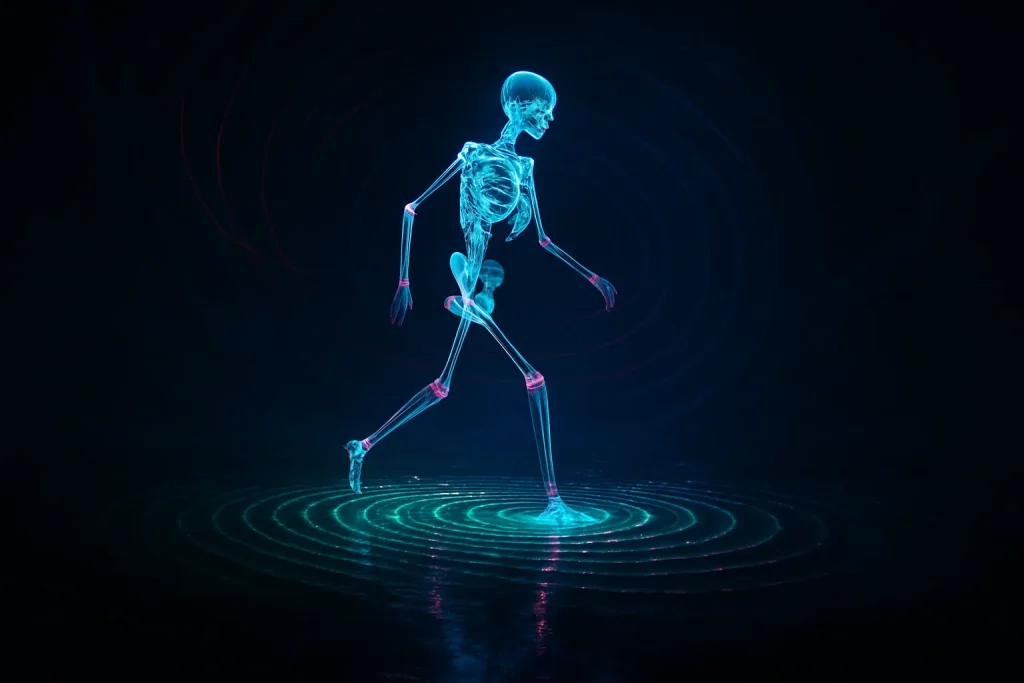
Gait can also be captured close up by a phone’s accelerometer and gyroscope, by pressure sensors hidden in flooring, or even by short-range radar that reads the micro-Doppler signature of moving limbs through walls. Once these sensors are deployed, gait becomes one of the hardest biometrics to evade.
Keystroke Dynamics: This tracks typing patterns, such as speed, pause duration, and key pressure. It’s used in cybersecurity to verify users during login or detect unauthorized access.

For example, banks employ keystroke dynamics to monitor online transactions. The technology is cost-effective and software-based but requires consistent user behavior for optimal accuracy.
Signature Recognition: This analyzes handwritten signatures based on stroke patterns, speed, and pressure. It’s common in banking and legal document verification.

Digital signature pads enhance accuracy by capturing dynamic data, but inconsistencies in signing can lead to false rejections.
Behavioral biometrics excel in continuous authentication, ensuring a user remains authorized throughout a session, but they are generally less accurate than physiological methods due to behavioral variability.
How Biometrics Work
Biometric systems operate through a structured process involving enrollment, storage, and comparison, supported by advanced hardware and software. Understanding this process is key to appreciating both the technology’s strengths and vulnerabilities.
- Enrollment: The first step involves capturing a biometric trait using specialized sensors. For example, a fingerprint scanner records ridge patterns, while a facial recognition camera captures landmarks like eye spacing. The system uses algorithms to convert this raw data into a digital template—a mathematical representation of key features. For instance, minutiae-based algorithms for fingerprints identify ridge endings and bifurcations. This template is compact, typically a few kilobytes, to ensure efficient storage and comparison.
- Storage: The biometric template is securely stored, either in a centralized database (e.g., for government ID systems) or locally on a device (e.g., a smartphone’s secure enclave). To protect privacy, raw images or recordings are not stored; only the non-reversible template is retained. Encryption and secure protocols, such as AES-256, safeguard templates against unauthorized access.
- Comparison: During authentication, the system captures a fresh biometric sample, generates a new template, and compares it to the stored one using matching algorithms. A similarity score determines if the templates match within a predefined threshold. For example, facial recognition systems may use neural networks to compare 128 facial vectors. If the score exceeds the threshold, access is granted.
Key components include:
- Sensors: Fingerprint scanners, cameras, or microphones capture biometric data.
- Processing Units: Computers or embedded chips convert raw data into templates.
- Algorithms: AI-driven algorithms, like deep learning models, enhance matching accuracy.
- Storage Systems: Secure databases or hardware modules like Trusted Platform Modules (TPMs) protect templates.
Challenges in this process include ensuring sensor quality, preventing spoofing (e.g., using liveness detection to verify live traits), and maintaining template security.
For privacy-conscious users, understanding how biometric data is handled is critical to assessing risks.
Applications of Biometrics
Biometric technology is transforming industries by enhancing security, efficiency, and user experience. Below, we explore its diverse applications, emphasizing real-world impact and relevance to security-conscious audiences.
- Access Control: Biometrics secure both physical and digital access. Smartphones like the Google Pixel use fingerprint or facial recognition to unlock devices, while corporate offices employ iris scanners for restricted areas. The global biometric access control market is projected to reach $15 billion by 2027, reflecting its widespread adoption.
- Financial Services: Banks leverage biometrics to combat fraud and streamline transactions. For example, HSBC uses voice recognition for phone banking, and India’s Aadhaar system enables fingerprint-based payments for over 1.3 billion citizens. Biometrics reduces identity theft, with studies showing a 50% drop in fraud incidents at biometric-enabled ATMs.
- Law Enforcement: Biometrics is a cornerstone of modern policing. The FBI’s Next Generation Identification (NGI) system uses fingerprints, facial recognition, and iris scans to maintain a database of over 50 million individuals. This aids in suspect identification and missing person cases but raises concerns about mass surveillance.
- Border Control and Immigration: Biometrics streamline international travel while enhancing security. The U.S. Customs and Border Protection’s TVS uses facial recognition to verify travelers against passport photos, processing over 100 million passengers annually. Programs like India’s Aadhaar and the EU’s Entry/Exit System (EES) use biometrics to prevent identity fraud.
- Healthcare: Biometrics ensures accurate patient identification, reducing medical errors. The CDC’s biometric programs in Haiti and Zambia use fingerprints to track over 200,000 patients, improving disease management. Hospitals also use biometrics to secure electronic health records (EHRs), protecting sensitive data.
- Time and Attendance: Organizations use biometrics to track employee hours, eliminating “buddy punching” (where employees clock in for absent colleagues). Biometric time clocks, like those from Kronos, improve payroll accuracy and reduce labor costs by up to 2% annually.
These applications demonstrate biometrics’ versatility, but their widespread use underscores the need for robust security measures to protect user data.
Benefits of Biometrics
Biometrics offers compelling advantages, making it a preferred choice for authentication in security-conscious environments:
- Enhanced Security: Biometric traits are unique and difficult to replicate, reducing the risk of unauthorized access. For example, iris recognition has a false acceptance rate of 1 in 1.2 million, far surpassing passwords.
- Convenience: Users don’t need to memorize complex passwords or carry physical tokens, as biometric traits are always available. This is particularly valuable for mobile banking and device access.
- Non-transferability: Unlike passwords or ID cards, biometrics cannot be shared or stolen, ensuring the authenticated user is the legitimate one.
- Reduced Fraud: Biometrics minimizes identity theft and fraud. For instance, biometric ATMs have reduced card skimming incidents by 30% in some regions.
- Scalability: Biometric systems can handle large populations, as seen in India’s Aadhaar program, which manages biometric data for over 1.3 billion people.
These benefits make biometrics an attractive solution for individuals and organizations seeking to balance security with user experience.
Security and Privacy Concerns
Despite its advantages, biometrics raises significant concerns, particularly for those prioritizing privacy and security. Below, we delve into these challenges and offer strategies to mitigate risks.
- Data Breaches: Biometric data is immutable—unlike passwords, it cannot be changed if compromised. The 2015 U.S. Office of Personnel Management breach exposed 5.6 million fingerprints, highlighting the catastrophic impact of such leaks. Encrypted storage and secure transmission protocols are essential to prevent unauthorized access.
- Spoofing and Presentation Attacks: Attackers may use fake fingerprints, high-resolution photos, or 3D-printed masks to bypass biometric systems. Modern systems counter this with liveness detection, such as requiring eye blinks or thermal imaging to confirm live traits. For example, Apple’s Face ID uses depth-sensing cameras to prevent photo-based spoofing.
- Privacy and Surveillance: Biometric technologies, particularly facial recognition, enable mass surveillance, raising ethical concerns. China’s social credit system, which uses facial recognition to monitor citizens, has sparked global debates about privacy violations. In response, cities like San Francisco have banned facial recognition in public spaces.
- Legal and Ethical Issues: Regulations like the EU’s General Data Protection Regulation (GDPR) and Illinois’ Biometric Information Privacy Act (BIPA) require explicit consent, transparent data handling, and the right to data deletion. Non-compliance can result in hefty fines, as seen in a $650 million settlement against Facebook for BIPA violations.
- Bias and Discrimination: Biometric systems can exhibit bias, particularly in facial recognition, where darker-skinned and female faces have higher error rates. A 2018 NIST study found that facial recognition algorithms misidentified Black and Asian faces up to 100 times more often than White faces. Developers must prioritize diverse training data to address these disparities.
Mitigation Strategies:
- Encryption: Use end-to-end encryption for biometric templates during storage and transmission.
- Decentralized Storage: Store templates on devices rather than centralized databases to reduce breach risks.
- Multi-Factor Authentication (MFA): Combine biometrics with passwords or tokens for layered security.
- Transparency: Organizations should disclose how biometric data is collected, stored, and used, ensuring compliance with GDPR and BIPA.
- Regular Audits: Conduct security audits to identify and address vulnerabilities in biometric systems.
- On-device storage and secure elements: For truly private biometrics all templates should stay on the device inside a tamper-resistant secure element such as Apple’s Secure Enclave or Google’s Titan M2. Apps receive only a yes-or-no answer, never the raw fingerprint or face data. Avoid hardware that lacks this dedicated chip.
- Algorithm transparency: Every biometric system lives or dies by its matching algorithm. Android publishes test guidelines for manufacturers, and independent security researchers regularly probe popular sensors for spoofing resistance. When you assess a phone or door lock, look for third-party test results rather than marketing claims.
For privacy-conscious users, choosing providers with strong data protection policies and opting for device-based biometrics (e.g., smartphone Face ID) can minimize risks.
The Future of Biometrics
The biometric industry is poised for significant growth, with the global market expected to reach $82 billion by 2027. Emerging trends are shaping a more secure, accessible, and privacy-focused future:
- AI and Machine Learning Integration: AI enhances biometric accuracy by improving algorithms. NIST’s 2020 evaluation showed facial recognition accuracy improving from 4% error rates in 2014 to 0.08%. Deep learning models adapt to diverse populations, reducing bias.
- Multi-Modal Biometrics: Combining multiple traits, such as fingerprints and facial recognition, improves accuracy and security. For example, airports are adopting multi-modal systems to verify travelers, reducing false rejections.
- Contactless Authentication: The COVID-19 pandemic accelerated demand for touchless biometrics, such as facial and iris recognition, for hygiene reasons. Contactless systems are now standard in airports and retail.
- Expansion into New Industries: Biometrics is entering retail for personalized customer experiences (e.g., Amazon Go stores using palm recognition) and automotive for driver authentication in autonomous vehicles. These applications enhance convenience but require robust privacy safeguards.
- Privacy-Enhancing Technologies: Innovations like homomorphic encryption allow biometric processing without exposing raw data. The Biometrics Institute’s updated privacy guidelines for 2025 emphasize ethical data use.
- Regulatory Evolution: Governments are tightening biometric regulations. The EU’s AI Act, expected to be fully enforced by 2026, will mandate transparency and bias mitigation in biometric systems, ensuring user trust.
These trends indicate a future where biometrics is more accurate, inclusive, and privacy-conscious, but ongoing vigilance is needed to balance innovation with ethical considerations.
Conclusion
Biometrics is transforming how we secure our digital and physical worlds, offering unparalleled security and convenience compared to traditional authentication methods. From unlocking smartphones with a glance to streamlining international travel, its applications are vast and growing.
However, the technology’s reliance on immutable personal data raises significant privacy and security concerns, particularly for those wary of surveillance or data breaches. By adopting best practices—such as encryption, decentralized storage, and compliance with regulations like GDPR and BIPA—users and organizations can mitigate risks while harnessing biometrics’ potential.
As the industry evolves with AI, contactless solutions, and stricter regulations, staying informed is crucial. Whether you’re a security professional, privacy advocate, or everyday user, understanding biometrics empowers you to make informed decisions about your data. By prioritizing transparency and ethical use, we can build a future where biometrics enhances security without compromising personal freedom.
A distant cousin to the famous rogue operative and with all the same beliefs. I enjoy exposing unseen threats to your privacy and arming you with the knowledge and resources that it takes, to stay invisible in a world that’s always watching.
- Edword Snowenhttps://stealthkits.net/author/snowen/
- Edword Snowenhttps://stealthkits.net/author/snowen/
- Edword Snowenhttps://stealthkits.net/author/snowen/
- Edword Snowenhttps://stealthkits.net/author/snowen/

